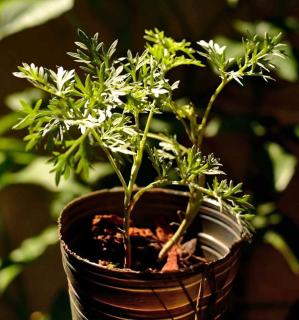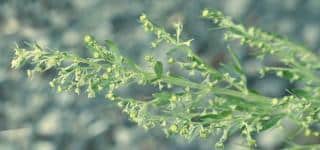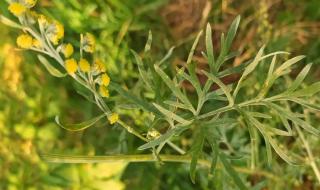

Absinthe is more famous for the liquor that is produced from it than for its many uses in the garden.
A summary of Absinthe facts
Name – Artemisia absinthium
Family – Asteraceae
Type – semi-evergreen perennial
Height – 16 inches to 5 feet (40 to 150 cm)
Exposure – full sun
Soil – rich and light
Harvest – May to October
Nonetheless, it is a spice herb, has many medicinal properties, and is a great repellent in the vegetable patch.
Absinthe helps fight against aphids, carrot fly, large white and flea beetle.

It grows quickly in pots, too, though needs frequent fertilizing.
Absinthe can be sown directly in the soil all spring and summer long.
As soon as the plants have formed 4 or 5 leaves, you can thin to about 8 inches (20 cm) to give the seedlings space to grow.
It is very easy to multiply absinthe by dividing old clumps.

It is best to snip the stems off one at a time whenever you need some, instead of tearing out a whole bunch.
In fall, in order to keep your absinthe for the longest possible span of time, cut it short and keep in frozen in a jar, with the stems and leaves whole.
It’s also possible to dry the leaves in a dry place where the air circulates well, crush the leaves and store them in an airtight jar.

Covered with silvery velvety hairs, it bears cute little yellow flowers all summer long.
Garden use is common for the positive impact it has on growth of other plants, and also because it is a repellent against certain parasites. For that, it can either be prepared as a fermented tea or simply planted in the middle of the vegetable patch.
Absinthe also has medicinal properties and health benefits for the body. It was often used to treat stomach disorders, to fight drowsiness, and also to limit the effect of travel sickness and nausea.
First, you must have dried the flowers in the shade. For maximum potency, collect leaves at the peak of the blooming season.
Learn more about herbs and spices:
Herbs and spices, all you need to know about growing them
To regenerate your absinthe, perform crown division in spring every three years, if you can.
Absinthe has repellent properties against dog fleas, especially outside the blooming season. A smart tip is to stash a few absinthe leaves in the dog’s basket to serve as a flea repellent.